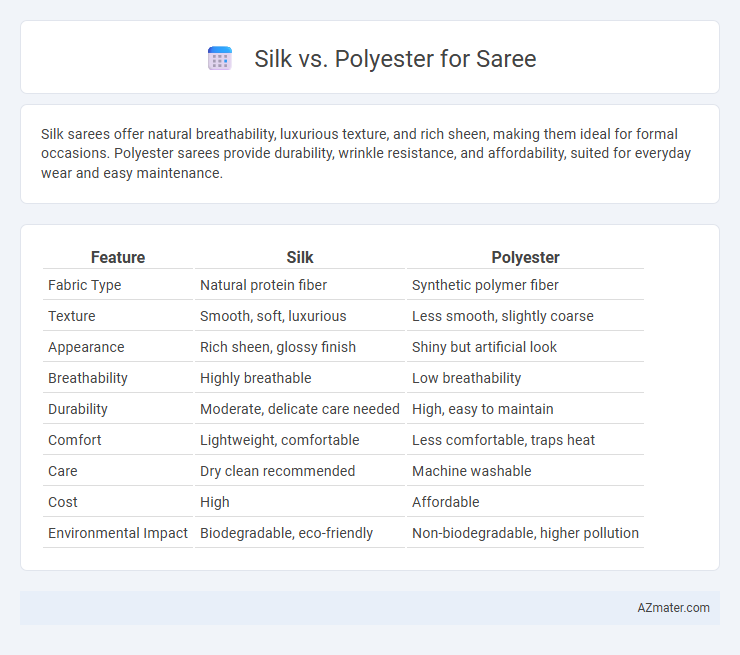Silk sarees offer natural breathability, luxurious texture, and rich sheen, making them ideal for formal occasions. Polyester sarees provide durability, wrinkle resistance, and affordability, suited for everyday wear and easy maintenance.
Table of Comparison
| Feature | Silk | Polyester |
|---|---|---|
| Fabric Type | Natural protein fiber | Synthetic polymer fiber |
| Texture | Smooth, soft, luxurious | Less smooth, slightly coarse |
| Appearance | Rich sheen, glossy finish | Shiny but artificial look |
| Breathability | Highly breathable | Low breathability |
| Durability | Moderate, delicate care needed | High, easy to maintain |
| Comfort | Lightweight, comfortable | Less comfortable, traps heat |
| Care | Dry clean recommended | Machine washable |
| Cost | High | Affordable |
| Environmental Impact | Biodegradable, eco-friendly | Non-biodegradable, higher pollution |
Introduction: Silk vs Polyester Sarees
Silk sarees, known for their natural fibers and luxurious texture, offer superior breathability and a rich sheen, making them ideal for traditional and formal occasions. Polyester sarees, made from synthetic fibers, provide durability, wrinkle resistance, and affordability, making them a practical choice for everyday wear. The choice between silk and polyester depends on factors like comfort, occasion, maintenance, and budget preferences.
Fabric Origins: Silk and Polyester Explained
Silk, a natural protein fiber produced by silkworms, originates predominantly from regions like India and China, known for their rich sericulture history. Polyester, a synthetic polymer created through chemical processes involving petroleum products, was first developed in the mid-20th century and represents a modern fabric alternative. Understanding these contrasting fabric origins highlights the traditional elegance of silk versus the durable, easy-care qualities of polyester sarees.
Texture and Feel: Comfort on the Skin
Silk sarees offer a smooth, natural texture that feels lightweight and breathable, providing exceptional comfort on the skin, especially in warm climates. Polyester sarees, made from synthetic fibers, tend to have a slightly stiff and less breathable texture, which may cause discomfort during prolonged wear. Silk's hypoallergenic properties enhance its comfort level, making it ideal for sensitive skin compared to the less skin-friendly nature of polyester.
Appearance: Shine and Drape Comparison
Silk sarees exhibit a natural, lustrous shine and a fluid drape that accentuates the garment's elegance and rich texture, making them ideal for formal occasions. Polyester sarees, while often designed to mimic silk's glossy finish, generally have a less authentic shine and a stiffer drape, which can affect the saree's overall flow and comfort. The distinct shine and graceful drape of silk enhance the saree's visual appeal, whereas polyester prioritizes affordability and durability over luxurious appearance.
Durability and Longevity Factors
Silk sarees are known for their natural strength and resilience, offering excellent durability with proper care, often lasting decades due to their high-quality protein fibers. Polyester sarees, made from synthetic fibers, provide enhanced resistance to wrinkles and stains, making them more durable for daily wear and easier maintenance over time. Longevity of silk sarees depends heavily on storage and handling to prevent damage from moisture and sunlight, while polyester sarees maintain their vibrant color and fabric integrity even with frequent washing.
Maintenance: Cleaning and Care Differences
Silk sarees require delicate handling, often needing dry cleaning to preserve their sheen and prevent damage to the natural fibers. Polyester sarees offer easier maintenance since they can typically be hand-washed or machine-washed without losing color or texture. Regular use of mild detergents and avoiding high heat drying is essential for polyester, while silk demands storage in breathable covers to avoid moisture and mildew.
Breathability and Climate Suitability
Silk sarees offer excellent breathability due to natural protein fibers that allow air circulation, making them suitable for moderate to cool climates. Polyester sarees, made from synthetic fibers, tend to trap heat and moisture, reducing breathability and causing discomfort in hot and humid weather. Choosing silk ensures better temperature regulation and comfort during extended wear in diverse climatic conditions.
Price Point: Affordability and Value
Silk sarees typically carry a higher price point due to the labor-intensive harvesting and weaving processes, offering luxurious texture and longevity. Polyester sarees present a more affordable alternative, providing durability and ease of maintenance without compromising on vibrant colors and patterns. Consumers seeking value often weigh the premium cost of silk against polyester's budget-friendly nature and practical benefits.
Eco-Friendliness and Sustainability
Silk sarees are biodegradable and derived from natural protein fibers, making them a more sustainable and eco-friendly choice compared to polyester, which is a synthetic, petroleum-based fabric that contributes to microplastic pollution. The cultivation of silkworms and mulberry trees promotes biodiversity, while polyester production relies on fossil fuels and emits harmful greenhouse gases. Choosing silk supports renewable resources and waste reduction, whereas polyester sarees pose challenges for recycling and long-term environmental impact.
Choosing the Right Saree: Key Takeaways
Silk sarees offer unparalleled elegance and durability, rich in natural fibers that ensure breathability and comfort, making them ideal for special occasions. Polyester sarees provide affordability, easy maintenance, and wrinkle resistance, suited for everyday wear and travel. Prioritizing fabric quality, occasion, and care requirements helps in selecting the perfect saree that balances aesthetics and practicality.

Infographic: Silk vs Polyester for Saree
 azmater.com
azmater.com